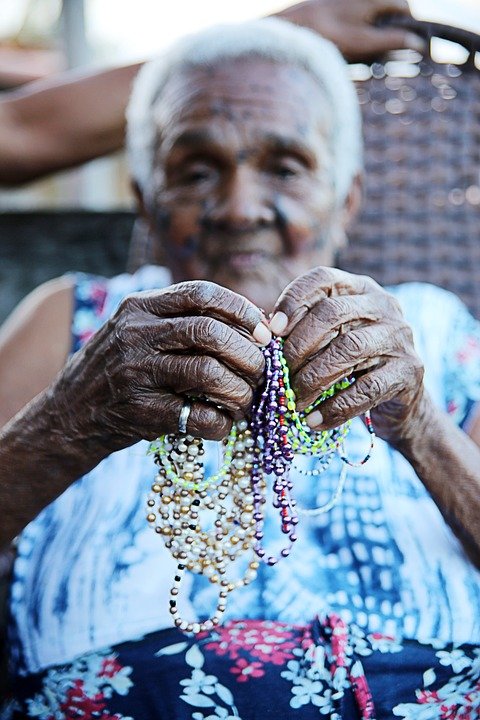"Tales From The Plum Corner" - Chapter 3: María Güesito

Third installment of my mother's childhood memories.

Her real name was María Amparo Pantoja, and she came from Calabozo with her partner Manuel aka “El Flaco”, who was a “pesador de cochino”. They shared with their children a “bahareque” house right in front of ours.
The reason she was called “Güesito” was because when little she was extremely skinny, in stark with her sister Rosa. People used to say that it was because she swallowed the seeds from the Plums, which wasn’t true, but what she actually swallowed were the big “seeds” of the “Mamón”, which we called “pepas”.
The Pantoja family ate just two times a day, with breakfast at 8am and lunch/dinner at 3pm. This second meal was the most anticipated by us, not because we were invited to eat with them, but rather because María religiously send us a small bowl with caraotas with a special touch of pepper and sugar. We always fought for them, but at least we had some every day. The other dish we always cherished from María were the cow ribs made with rice and cooked in a bonfire, which gave them a very particular flavor.
In relatively recent years, María was benefited with the social program called “Rancho por Casa”, and even though she actually got a new one, she prefered to stay in her old “bahareque” house where she ignored the common technology of washing machines and gas stoves to still wash by hand in her “batea” and to cook in bonfires. Those things made her happy, just like I became every time I visited Las Mercedes and ate her caraotas.
Like every other “llanero”, María and Manuel went to sleep early. We the children stayed playing in the streets, accompanied by the meek and gentle dairy cattle of my grandfather, and using compost as make-believe birthday cakes and such. My uncle Carmelo frequently brought us left-over meat from the slaughterhouse, which we roasted “ternera” style and ate with green “topocho sancochado”, and those were our child parties.
I don’t remember ever going to a birthday party like the ones nowadays, with piñatas, instead, we filled a “tapara” with 1 “locha” of caramel that we bought from Jorge Rodríguez’s General Store, and who also frequently invited us to eat alongside his children Judith, Blanca, Magaly, Katiuska, Teresa, Julián and Jorge Luis, and his wife Rosa, a very sweet and nice lady, godmother of my sister Maritza.
In that way passed our healthy childhood, away from any real danger, without evil in our actions or thoughts, breathing the pure air that nature gave us before being spoiled by time and mankind’s abuse.

Glossary (in order of mention):
-Calabozo: A city in Guárico State, its name could be translated into “dungeon” or “prison cell”.
-Pesador de Cochino: an employee of an slaughterhouse, charged with weighting the pigs (cochinos).
-Bahareque: An old type of construction method and also material. A bahareque house is made creating a framework of wood or thick bitter cane (grumpy and foul-tasting cousing of sugar cane) and then filling it and covering it with a mix of clayey earth and and straw. It makes for a very fresh and cheap house.
-Güesito: an intended mispronunciation of “huesito”, a diminutive of “hueso”. In short, it means “small bone”, or in this context “skinny”.
-Mamón: the fruit of a tree, and the tree itself, also called “Melicoccus bijugatus” by more scientific brains, and “Spanish lime” by others. It’s small and with a green husk, inside of which there is a light orange meaty pulp of sweet flavor when ripen.
-Pepas: a word used to describe anything that is small, hard, and round or rounded. In this context, the big seeds of a three.
-Rancho por Casa: a social program of ex-president Hugo Chavez government in which a person of low income living in an old or improper building (rancho) would be given a more modern house. Nice in theory, but ended up being consumed by corrupt officers and scams.
-Batea: kind of like a small raised bathtub used for washing clothes. On one side, slightly more elevated than the rest, it has a texturized surface made to scrub the clothes there.
-Llanero: a person from the “llanos”, a region composed of the central plains of Venezuela. Our version of cowboys.
-Ternera: a Word used ton ame some cows, and also the method of roasting big pieces of meat over an open fire, with wood that makes it have a smoky flavor.
-Topocho: a type of banana, not all that good for deserts, but tastes amazing when smashed, fried and sprinkled with salt and powdered garlic, which is when they are called “tostones”. It is also eaten parboiled.
-Sancochado: parboiled.
-Tapara: the husk of the “Taparo” tree’s fruit. While not exactly tasty for humans, its empty and dried husk hardens enough to replace many wooden objects. Frequently used to make dishes, forks, spoons, bowls and the musical instrument called “maracas”.
-Locha: a low denomination coin that was used mainly in daily small purchases. Nowadays, with the raging hyper-inflation, “locha” is used as a synonym for small amounts of money, most likely to point that a person has no money at all: “no tengo ni una locha”= “I have no money”.

Hola dranuvar,
Tu post ha sido seleccionado por el bot de @provenezuela, te hemos dado un voto en apoyo a los autores venezolanos!
Gracias por ser parte de nuestra comunidad!
Hello @dranuvar, thank you for sharing this creative work! We just stopped by to say that you've been upvoted by the @creativecrypto magazine. The Creative Crypto is all about art on the blockchain and learning from creatives like you. Looking forward to crossing paths again soon. Steem on!